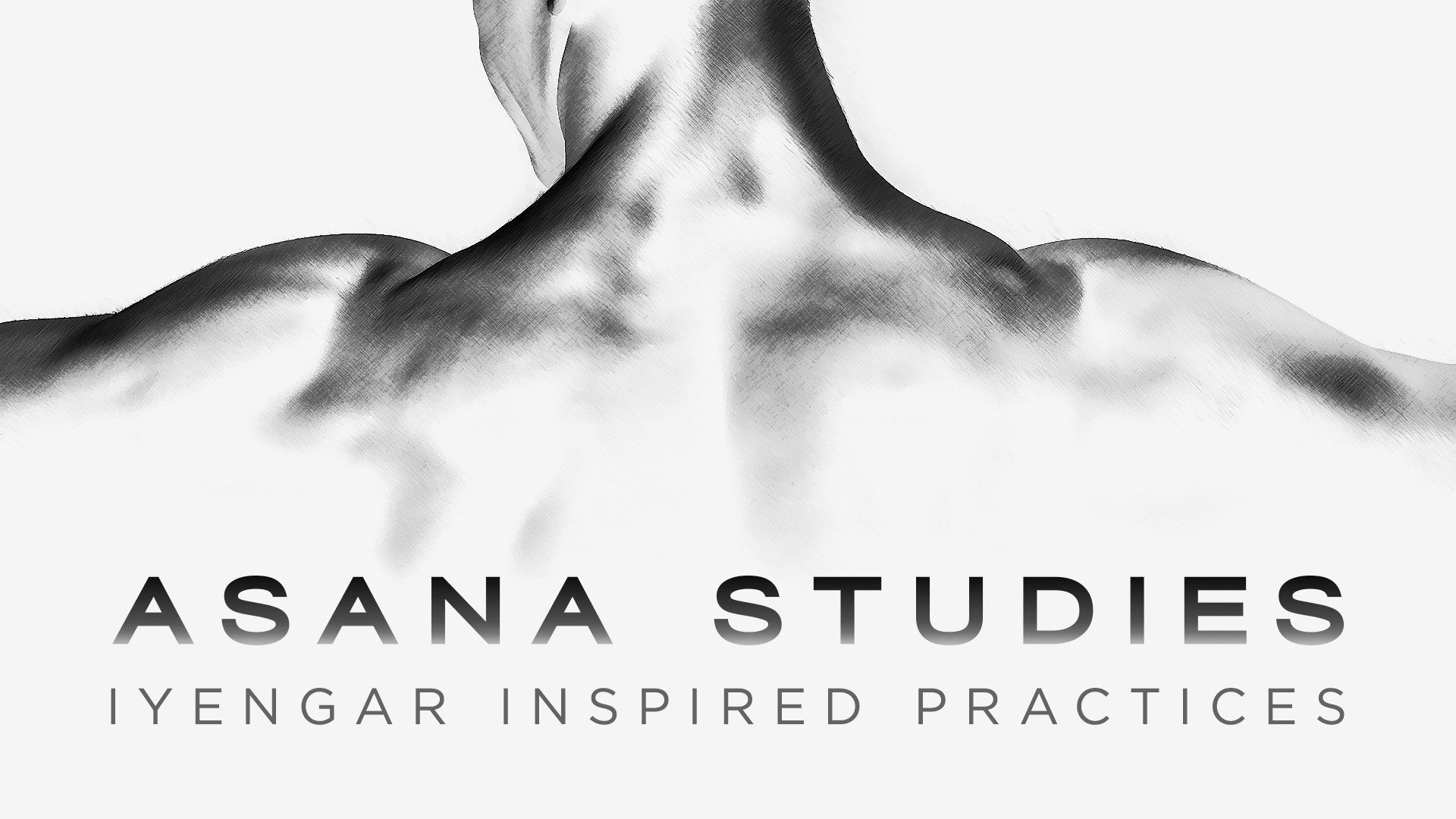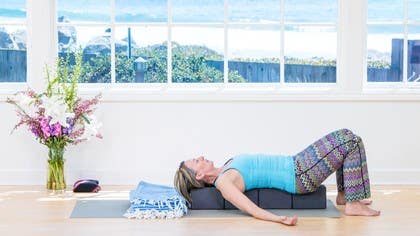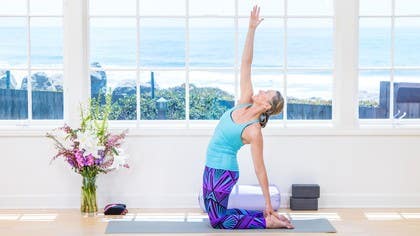Description
About This Video
Transcript
Read Full Transcript
(ocean waves crashing) Hey there. Today we're going to do a very cooled out, quiet practice. It just has a little bit of a prop setup. What you need are four blocks and two blankets. So have two blankets that are folded like this, these smaller rectangle shapes, right?
You can stack one on top of the other, and place that toward the top of your mat. Then take four blocks. I'm using four foam blocks, you know, standard size. You want all the blocks to be the same size. You're going to make a track on the middle of your mat, one block in front of the next.
There we go. Then make sure that the blocks are really straight, and that they're placed in a line in the center of the mat, so you have equal distance on either side of this track, okay? Then you can bring these blankets close to the top of this track. All right, and then you're going to sit on, let's call this the first block. You'll sit on the first block.
All right, feet grounded. Use your hands to help guide you back. You want to keep your body right in the middle of the blocks, and when you lay down, you don't want your head falling off the first block, so you have to make sure that you get the full support of all the blocks under your central axis, right? Under your midline, under your spine. Then just get yourself set so you feel that you're not wobbling or teetering in any direction, so that your body really can zone into what center is.
Turn your palms towards the ceiling. Lay your arms down. Feel the feet solid and grounded. Just a few simple breaths, easy breaths. You might be able to perceive how the edge of the blocks allows the shoulder blades to drop towards the floor a bit.
The blocks are running along the inner border of the shoulder blades. To find that, you just lift your hands up off the floor. You kind of press your shoulder blades in towards your spine, and see if you can kind of snuggle and grab the blocks with your shoulder blades. Then you relax that action. Okay, maybe we should just call this the inchworm, because you want to inch your body along the blocks in the direction of the head until your head is just catching that rounded edge of the block, so the base of the skull is flat and broad, and you want to be just feeling that bottom edge of your skull, which is called the occipital ridge, rolling over that rounded end of the block.
All right, take a breath. Check in, what kind of feedback is this giving you? It's nice to just little movements, like turning the head one way, or turning the head the other way, so you have control over how much pressure is coming through your skin into that occipital ridge. Little nodding yes, rolling that edge. Then you can inchworm, so you just have to loosen your skin on the blocks and come off a little bit more.
You know, this can get into some tender area. The minute that you feel your head really fall down, you have the blankets close. You can just pull them, or even fold them up higher if you need, to support the weight of the head so you can explore the feedback, the conversation between the edge of the block and your body. All right, so inching along a little further. Adjusting your blankets, like it's time for me.
I don't really need that extra bit, so now you're going to count your vertebrae, and the top vertebrae, which we'll call C1, which is called C1, is so deep up there that you're not going to be able to feel it with the block, but you might catch C2 or 3. All right, any little movements to receive the gentle pressure of the block into that upper spine. Close your eyes. Then inch it along. This is where I need to actually remove one of the blankets.
Then I can let my head fall back a little further. Just be aware of when that happens for you. I'm sort of feeling it along the upper border of the shoulder blades, into that lower neck vertebrae. I have, also at my disposal, my feet, which if I push a little into my feet, I can roll a little more off the blocks and a little on. Right, so you can do that.
At this point, you want to be in the experience. You don't want to have to lift your head and look at me at all, so just know that I'm here. We're doing this together. Then you inch further along. At this point, it would be good to be at the base of the neck, so what we call C7, cervical 7, and T1, right in that area at the top of the thoracic spine.
This place can be pretty intense, so use the blanket as you need it. If it needs to be higher, get it. Mindful of the sensation that's coming through your skin into your body. We'll inch along again, so we're really looking to just move one vertebrae at a time. Now would be maybe T2.
Do you notice how my voice has changed? It's so interesting. You could, like, make some noise there so that as the pressure of the block comes from back to front, so through your spine into the softer tissues of the neck and the upper chest, it shifts things. Do take conscious breaths, and be aware of the gift of the prop. Inching along again.
Maybe we're at T3, in between those upper shoulder blades now. Breathing, open to the experience. Invariably, we get kind of seduced by certain sensations that give us some kind of relief. Invariably, we get seduced by wonderful sensations, and it makes us want to stay for a long time. If you get what we're doing here, you can certainly take your time with this, but it might also be worthwhile to just keep inching along, because there's always something new and interesting ahead.
Notice the response of your body to these actions. Inching along. Every once in a while, you'll have to move your feet. Lifting the hips, inchworming along the block. I want to emphasize that you're not dragging your skin.
You really have to lift up and then re-set. Lift up, and then re-set. If you get into any area that's a little frightening, go right to the breath, and be open to the fact that you might need to bring the blanket back under the head. Inching along, so now we're kind of mid shoulder blade level, or bottom tip of shoulder blade level, with the edge of the block pressing into the spine and creating a kind of curve there. Use your breath.
Notice if you're bracing anywhere against the experience. If there's too much intensity, bring the blanket so the weight of the head is just higher, right? You're not dropping your head back. All right, inch it along. Now we're definitely past the shoulder blades, and at this point, your head might be sliding onto the mat or the floor, but you don't want the shoulders to be kind of dangling in space, so you might have to bring the blanket right up under your shoulder blades.
Rock your feet a little closer in, and inch along. And inch along. If you've moved three or four vertebrae at a time, then go back a little bit, and just really try to step along through the spine. At some point, the blanket that's under your chest now, your shoulders and your chest, could be removed. You might not need it.
For me, I like to take it out. Once my shoulder blades are ready to come to the floor, I like to take it out, and it just gives me more feedback through the edge of the block. Inching along now. I'm way down at the base of my rib cage, so sort of in that T12, L1 region. Bottom rib cage, top of lumbar spine.
Can your belly receive the messages, right? Just bring your awareness to the experience. Keep going. Don't linger too long. Now, depending upon the shape of your body, your sacrum will be on the blocks and the upper chest will be on the floor.
Keep walking along. When you feel that, and you can use your hands even, for more of a guide, when you have that edge of your block at the top of the sacrum, you could take your feet up onto the blocks. It's a little narrow. You can just perch the legs there. Press the sacrum down.
Just feel that. I like to just take a little movement, just feel the balance of the sacrum. Right side, left side. Then feet back on the floor if you did that, and inch again. Picking up the hips, giving it space.
Now, the shape of the spine will change, and really, you have all the weight in that top block. Let that belly be soft, right? So keep receiving the information from the skin through the back body into the front body. Inching it along. I have to stabilize the block with my hand, because it's kind of tilty now, right?
This feels kind of wonderful, to go with the shape of the sacrum, so I'm very close to my tailbone now, in the bottom region of the sacrum. I can steady the block with my hand, inch my chest along, and allow the block to turn my tailbone up, and just keep inching along. I really, actually, just slide off that rounded edge of the block. At some point, I have to remove my hand. Inch along, inch along, until you can take your whole body, the whole length of your spine, onto the floor.
You can move so that you're really clear of the blocks. There might be an inch between that block and your skin, the skin of your buttocks. Stay for a moment here, tuning into your breath and letting the process go. Then you can bend your knees and take your feet onto the block. I like to cross my shins and lay my shin bones on the block, like an easy cross-legged position.
If that's not good for you, I would keep your feet on the floor, and just let the knees fall into each other, more like a constructive rest position. Then take any arm position that feels just right. Just put your arms in a place where they can drop. Stay here as long as you like. If you have your shins crossed, cross the other shin in front.
Stepping your feet on the floor, bring your knees up toward your chest. Roll to your side. You could actually just let that be an entry into your practice. Thank you. Namaste.
Asana Studies: Heidi Fokine
Comments
You need to be a subscriber to post a comment.
Please Log In or Create an Account to start your free trial.









